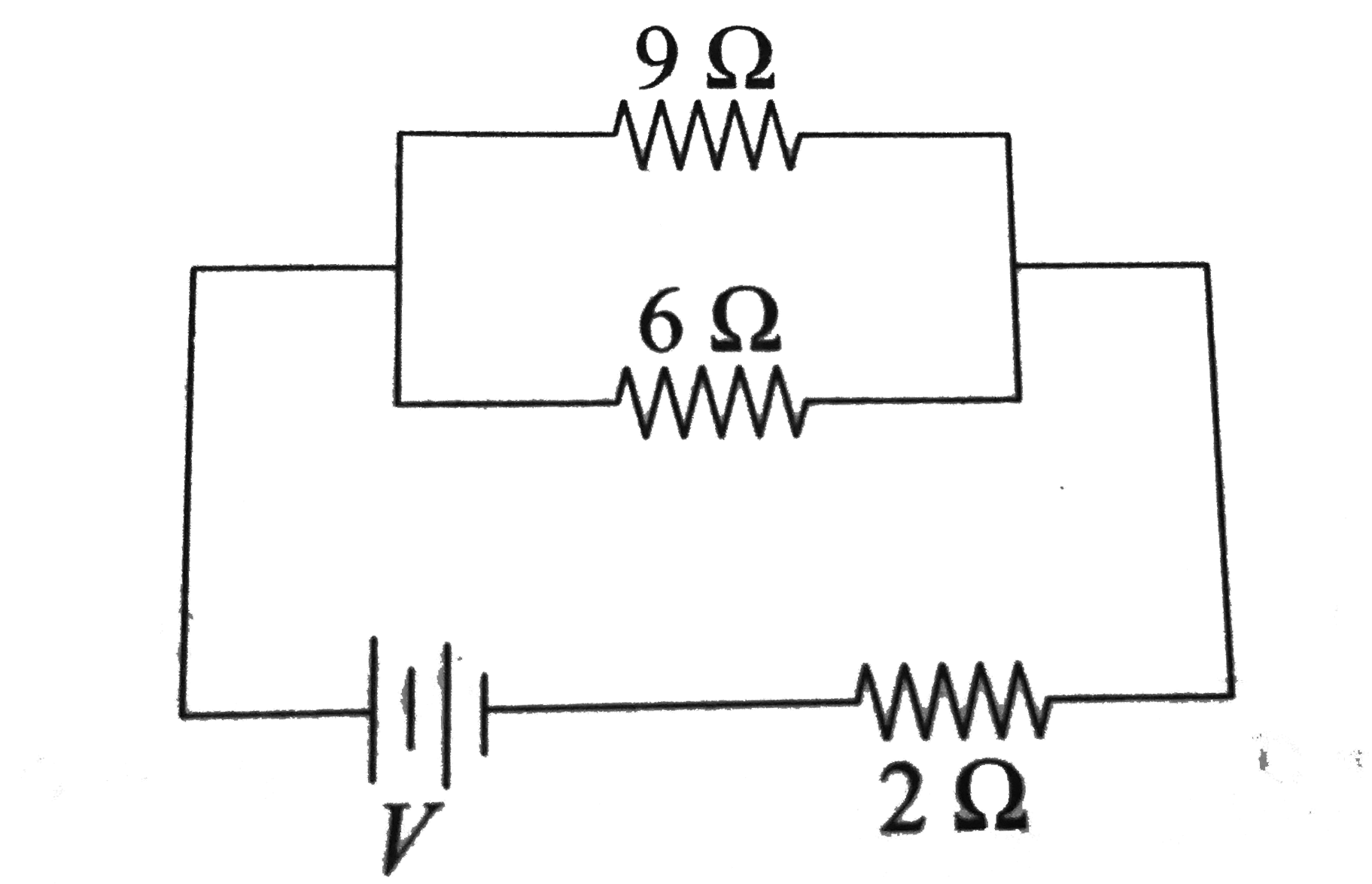Draw a circuit diagram of an electric circuit containing a cell, a key, an ammeter, a resistor of 2Ω in series with a combination of two resistors (4Ω each) in parallel and a voltmeter across the parallel combination. Will the potential difference across the 2Ω resistor be the same as that across the parallel combination of 4Ω resistors? Give reason.
The circuit is shown in figure. Effective resistance of combination of two resistors (4Ω each) in parallel is
Req=4×44+4=2Ω

Since the resistor of 2Ω and parallel combination of two 4Ω resistors are in series, same current will flow through these. Hence, the potential difference across 2Ω resistor is same as that across combination of two resistors.
Topper's Solved these Questions
- BOOK - VK GLOBAL PUBLICATIONCHAPTER - ELECTRICITYEXERCISE - LONG ANSWER QUESTIONS4videos
ELECTRICITY
- BOOK - VK GLOBAL PUBLICATIONCHAPTER - ELECTRICITYEXERCISE - NUMERICALS2videos
ELECTRICITY
- BOOK - VK GLOBAL PUBLICATIONCHAPTER - ELECTRICITYEXERCISE - SHORT ANSWER QUESTION-I8videos
ELECTRICITY
- BOOK - VK GLOBAL PUBLICATIONCHAPTER - LIGHT-REFLECTION AND REFRACTIONEXERCISE - PROFICIENCY EXERCISE (Long Answer Questions)5videos
LIGHT-REFLECTION AND REFRACTION
Similar Questions
Draw a circuit diagram of an electric circuit containing a cell, a key, an ammeter, a resistance of 2Ω in series with a combination of two resistors (4Ω each) in parallel and a voltmeter across the parallel combination. Will the potential difference across the 2Ω resistor be the same as that across the parallel combination of 4Ω resistors ? Give reason.
View SolutionDraw a circuit diagram of an electric circuit containing a cell, a key, an ammeter, a resistance of 2Ω in series with a combination of two resistors (4Ω each) in parallel and a voltmeter across the parallel combination. Will the potential difference across the 2Ω resistor be the same as that across the parallel combination of 4Ω resistors ? Give reason.
View Solution
Knowledge Check
- Question 1 - Select One
In the circuit shown below:

The potential difference across the 3Ω resistor is:A19VB12VC1VD2V - Question 2 - Select One
If power dissipated in the 9Ω resistor in the resistor shown is 36W, the potential difference across the 2Ω resistor is
 A8VB10VC2VD4V
A8VB10VC2VD4V
Draw a circuit diagram of an electric circuit containing a cell, a key, an ammeter, a resistance of 2Ω in series with a combination of two resistors (4Ω each) in parallel and a voltmeter across the parallel combination. Will the potential difference across the 2Ω resistor be the same as that across the parallel combination of 4Ω resistors ? Give reason.
View SolutionDraw a circuit diagram of an electric circuit containing a cell, a key, an ammeter, a resistance of 4Ω in series with a combination of two resistors (8Ω) in parallel and a voltmeter across the parallel combination. Each of them dissipate maximum energy and can withstand a maximum power of 16W without melting. Find the maximum current that can flow through the three resistors.
View SolutionDraw the circuit diagram of an electric circuit containing a battery of 6 V, a key , an ammeter , a resistor of 4Ω in series with a combination of two resistors of 8Ω each in parallel, and a voltmeter across the parallel combination.
(a) Calculate the resistance of the circuit .
(b) Find the current flowing in the circuit.
(c) What will be the voltage across the parallel combination of resistors?View SolutionDraw a circuit diagram of an electric circuit containing a cell, a key, an ammeter, a resistance of 4Ω in series with a combination of two resistors (8Ω) in parallel and a voltmeter across the parallel combination. Each of them dissipate maximum energy and can withstand a maximum power of 16W without melting. Find the maximum current that can flow through the three resistors.
View SolutionA resistor of 6 Ω is connected in series with another resistor of 4 Ω. A potential difference of 20 V is applied across the combination. Calculate :
the potential difference across the 6 Ω resistor.View SolutionIf power dissipated in the 9Ω resistor in the resistor shown is 36W, the potential difference across the 2Ω resistor is
 View Solution
View Solution

